Nostalgic gifts work by triggering your brain’s memory systems, creating emotional bonds through sensory cues like smells, sounds, and textures that evoke personal and cultural memories. These items often reinforce your identity and bring comfort by amplifying positive feelings and shared stories. As you explore these triggers, you deepen your emotional connection with others and enhance well-being. To discover more about how these powerful memories influence your experiences, keep exploring further.
Key Takeaways
- Nostalgic gifts evoke positive memories, activating brain reward pathways and releasing dopamine, which enhances emotional well-being.
- Memory recall during nostalgia strengthens emotional bonds and personal identity through shared experiences and meaningful objects.
- Sensory cues like scents and sounds serve as powerful triggers, instantly evoking vivid nostalgic memories.
- Cultural symbols and personal stories deepen emotional resonance, reinforcing collective and individual identities.
- Nostalgic gifts promote emotion regulation, reduce stress, and foster social connection through the reinforcement of positive past experiences.
The Role of Memory in Emotional Connection

Memory plays a crucial role in creating emotional connections through nostalgic gifts. When you give or receive these items, you tap into shared memories that strengthen social bonding. These memories evoke positive emotions, helping you regulate feelings during challenging times. Nostalgic gifts act as tangible links to the past, reminding you of meaningful experiences and relationships. As you recall these moments, your brain releases chemicals that foster feelings of happiness and comfort, making the emotional connection more profound. This process enhances empathy and trust, deepening your bond with others. By triggering familiar memories, nostalgic gifts facilitate emotion regulation, helping you manage stress and boost your mood. Incorporating immersive soundscapes into the experience can further enhance emotional engagement. Additionally, understanding the psychological effects of nostalgia can deepen the impact of these gifts, reinforcing emotional bonds in meaningful ways. Ultimately, they serve as powerful tools for cultivating lasting social connections grounded in treasured shared histories.
How Nostalgia Shapes Our Perception of the Past

Nostalgia influences how you interpret the past by emphasizing certain memories while diminishing others, often creating a more romanticized or idealized version of events. It’s like a form of mental time travel, where your mind selectively highlights positive moments and filters out the flaws. This process can lead to memory distortion, making the past seem better or simpler than it truly was. Your perception shifts as nostalgia encourages you to view previous experiences through a warm, sentimental lens. As a result, your memories aren’t exact reflections but reconstructed stories shaped by emotion and longing. This selective recall reinforces feelings of comfort and happiness, even if the reality was more complex. Interestingly, anime movies and animated films are often associated with nostalgic feelings because they frequently evoke childhood memories and simpler times. Additionally, emotional memory plays a crucial role in how nostalgia influences our perception by strengthening the emotional connections to certain memories. Ultimately, nostalgia crafts a personalized, often exaggerated, version of the past that influences how you remember and interpret your history.
The Brain’s Reward System and Nostalgic Triggers
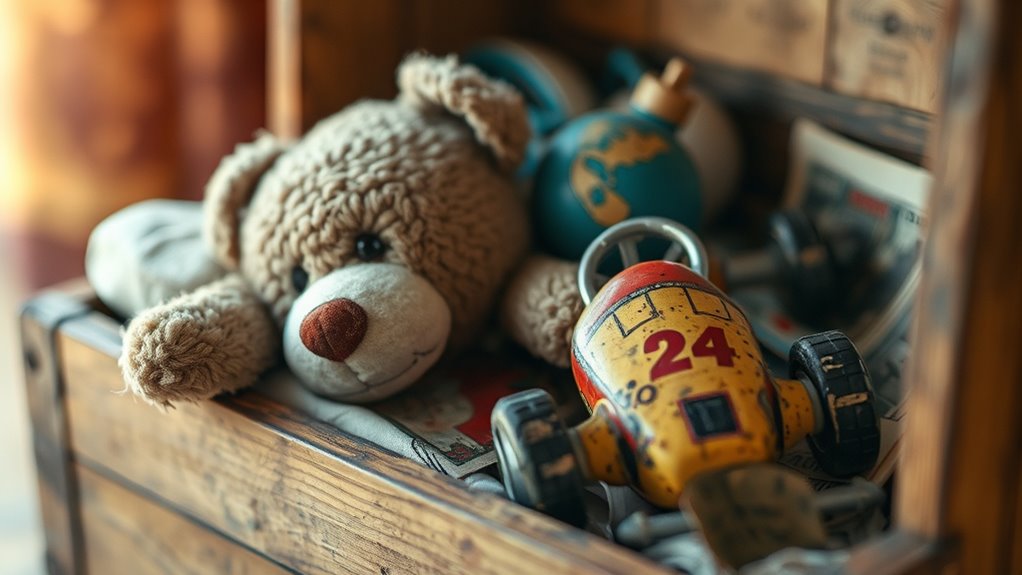
Your brain plays a key role in shaping how nostalgic feelings are triggered and experienced. When you encounter a familiar scent, sound, or object, your brain circuitry activates specific reward pathways that release feel-good chemicals like dopamine. These pathways connect regions responsible for emotion, memory, and pleasure, making nostalgic moments intensely rewarding. For example, revisiting an old gift or song can light up these reward pathways, reinforcing positive feelings associated with past experiences. This neural response explains why nostalgia feels so compelling and comforting—it’s your brain’s way of rewarding you for reconnecting with meaningful memories. Understanding the neural mechanisms behind these responses helps explain how certain triggers can effortlessly evoke powerful nostalgic emotions, highlighting the importance of brain connectivity in emotional experiences.
Cultural Influences on Nostalgic Preferences
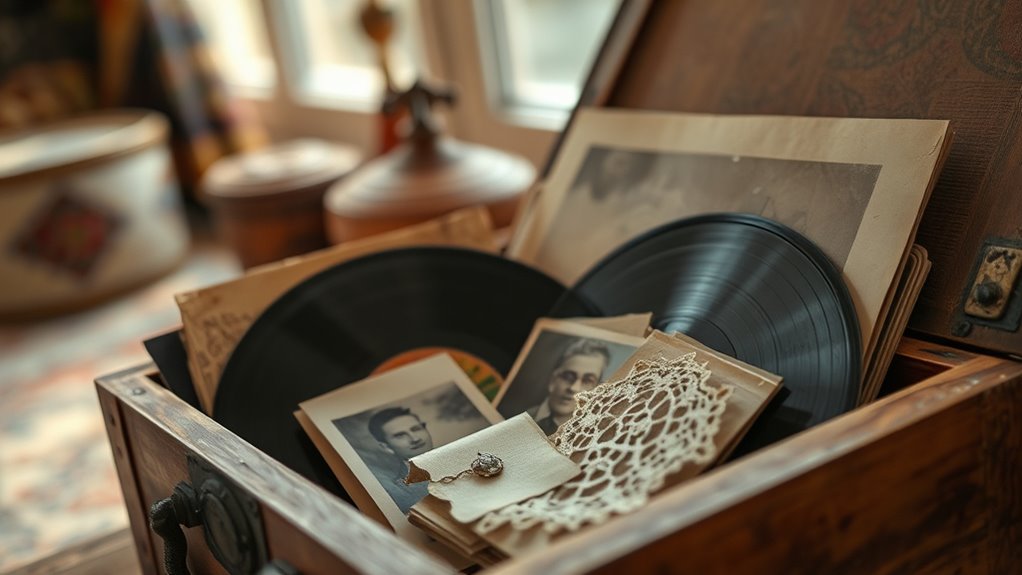
Your nostalgic preferences are shaped by the cultural artifacts and symbols that resonate with you, such as traditional crafts or iconic images. Regional childhood memories also play a key role, reminding you of specific places and experiences. Media and pop culture further influence what you find nostalgic, often connecting you to shared societal moments. Additionally, engaging in creative practice can help reinforce and rediscover these nostalgic feelings through active participation and exploration. Recognizing the importance of cultural intelligence can deepen your understanding of how cultural differences shape these preferences. Moreover, understanding social and cultural context can enhance your appreciation of the origins and significance of nostalgic symbols.
Cultural Artifacts and Symbols
Cultural artifacts and symbols profoundly shape our nostalgic preferences, serving as tangible links to familiar past experiences. When you see traditional crafts, such as handcrafted textiles or pottery, they evoke memories of cultural heritage and personal history. Similarly, historical symbols like flags, emblems, or iconic landmarks connect you to collective memories and shared identities. These artifacts act as powerful triggers, activating emotions tied to specific periods or cultural moments. They remind you of customs, values, and stories passed down through generations. By engaging with these symbols, you experience a sense of continuity and belonging. Whether displayed in a gift or kept as a keepsake, traditional crafts and historical symbols anchor your nostalgia in cultural authenticity, making your memories more vivid and meaningful. Incorporating cultural artifacts into gift-giving can also enhance emotional resonance and deepen the nostalgic connection.
Regional Childhood Memories
Regional childhood memories are deeply influenced by local customs, environments, and community traditions that shape your earliest experiences. The flavors of regional cuisine often evoke strong feelings, reminding you of family gatherings or local festivals that defined your childhood. Similarly, childhood games rooted in your community’s unique culture create lasting impressions—whether it’s a traditional game played in the streets or a neighborhood competition. These shared experiences forge a sense of identity and belonging, making them powerful triggers for nostalgia. When you encounter these familiar tastes or activities later in life, they can instantly transport you back to simpler, carefree moments. Incorporating authentic decor that reflects regional style can further deepen these nostalgic connections. Understanding these regional influences helps explain why certain gifts, like a favorite dish or a nostalgic game set, resonate so deeply.
Media and Pop Culture
Media and pop culture play a powerful role in shaping nostalgic preferences by embedding certain symbols, music, and trends into our collective memory. Media influence exposes you to iconic shows, movies, and advertisements that become intertwined with your personal history. Pop culture creates shared experiences, making references and references easily recognizable and emotionally resonant. When you encounter familiar characters or nostalgic tunes, your brain automatically recalls positive feelings linked to that era. These cultural elements serve as triggers, helping you reconnect with specific moments from the past. Additionally, the integration of music education philosophies in media can subtly influence how we perceive and value different musical styles and eras. By shaping your perceptions of what was enjoyable or meaningful, media influence and pop culture substantially impact the nostalgic gifts you value. They forge a collective sense of identity rooted in shared cultural memory, and collective cultural memory reinforces these nostalgic associations across communities. Furthermore, the portrayal of specific themes and aesthetics in media can reinforce particular cultural symbols, making them more prominent in our collective consciousness.
The Psychological Benefits of Nostalgic Experiences
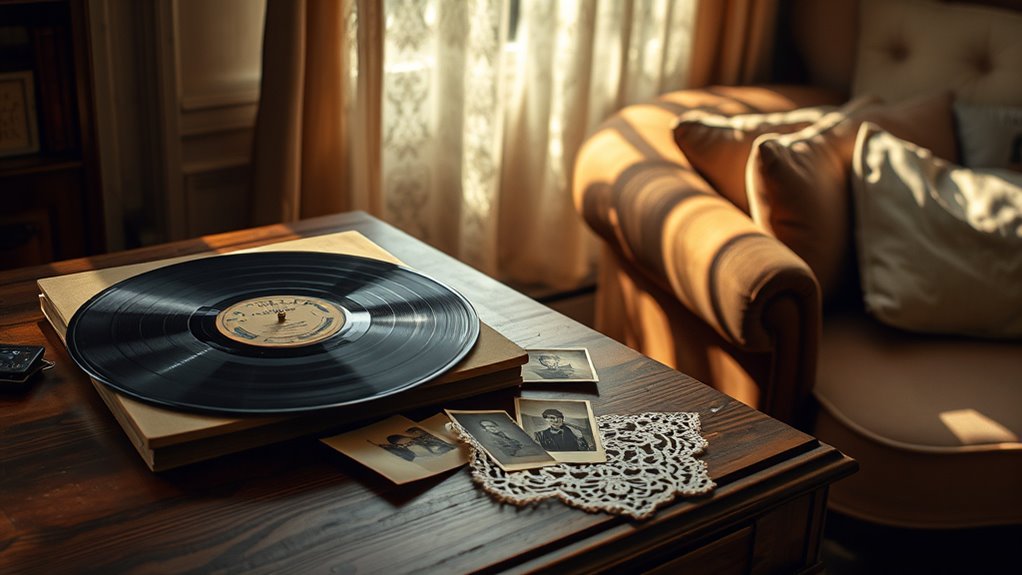
Nostalgic experiences can boost your positive emotions and make you feel more connected to your past. They also help reinforce your personal identity, giving you a sense of continuity. Plus, recalling these moments can reduce stress and promote overall well-being. Engaging with community support features in memory-related activities can further enhance feelings of belonging and motivation. Additionally, the use of intelligent tutoring systems in educational settings demonstrates how adaptive technologies can personalize experiences and foster deeper engagement. Regularly revisiting camping memories, such as outdoor adventures or new equipment, can deepen this sense of nostalgia and emotional fulfillment.
Enhances Positive Emotions
Experiencing nostalgic gifts can considerably boost positive emotions by reconnecting you with joyful memories from the past. These feelings elevate your mood and foster a sense of well-being. Nostalgia encourages emotion regulation, helping you manage stress and boost resilience. It also strengthens social bonding, reminding you of shared experiences with loved ones. This connection creates feelings of belonging and warmth. The table below illustrates how nostalgia influences emotions:
| Benefit | How It Works | Result |
|---|---|---|
| Emotion regulation | Revisits positive memories to soothe | Reduced stress, increased happiness |
| Social bonding | Reinforces shared experiences | Deeper connections, trust |
| Mood enhancement | Evokes warmth and joy | Overall positive outlook |
Additionally, understanding the psychological benefits of nostalgia can motivate individuals to seek out meaningful experiences that foster personal growth. Recognizing the role of positive memories in enhancing mental health can encourage more intentional engagement with nostalgic activities. For example, engaging in dog socialization can also promote positive emotional experiences by creating memorable interactions with others.
Strengthens Personal Identity
Connecting with nostalgic gifts helps you reaffirm your sense of self by anchoring your personal history. When you recall meaningful moments attached to these items, you reinforce your personal identity, making your sense of self more concrete. Nostalgic experiences remind you of who you are and where you’ve come from, strengthening your self-awareness. They serve as tangible evidence of your journey, values, and relationships. By engaging with these memories, you gain a clearer understanding of your identity’s evolution over time. This process fosters confidence and consistency in your self-perception, especially during times of change or uncertainty. Additionally, the emotional resonance of nostalgic gifts can stimulate the same brain regions involved in reward and motivation, further reinforcing your sense of self through positive associations. Recognizing the importance of cultural intelligence in understanding diverse perspectives can also deepen your appreciation of the cultural significance behind certain gifts, enriching your personal reflection. Maintaining regular reflection on these memories can strengthen your emotional resilience and sense of continuity. Ultimately, nostalgic gifts act as personal touchstones, helping you stay connected to your authentic self and deepening your understanding of your unique story.
Promotes Stress Reduction
When you engage with nostalgic gifts, they can serve as powerful tools for reducing stress and calming your mind. Scent memories and taste nostalgia often evoke comforting feelings that help you unwind. To maximize these benefits, consider:
- Breathing in familiar scents that trigger positive memories.
- Recalling favorite tastes from childhood or special occasions.
- Engaging with sensory items like old perfumes, baked goods, or music. Incorporating sensory stimulation can further enhance relaxation by activating multiple pathways in the brain.
- Exploring gelato flavors that remind you of happy moments or cultural traditions.
These sensory experiences activate your brain’s relaxation pathways and lower cortisol levels. By immersing yourself in scent memories or taste nostalgia, you create a mental escape from daily stressors. This emotional connection fosters a sense of safety and peace, making it easier to relax and regain focus. Nostalgic gifts therefore serve as natural stress-relievers, helping you feel more centered and calm.
The Impact of Sensory Cues on Memory Activation
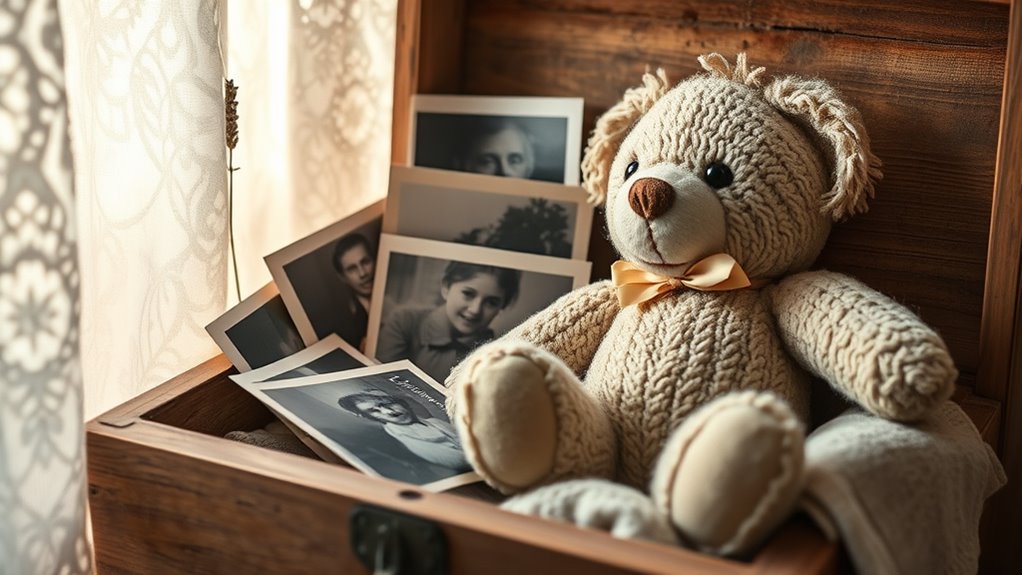
Sensory cues such as smells, sounds, and textures have a powerful ability to trigger specific memories almost instantly. Olfactory triggers, like the scent of baked cookies or a familiar perfume, can evoke vivid recollections from the past. Similarly, auditory cues—such as a song, a laughter, or a particular voice—can quickly bring back moments long forgotten. These sensory inputs activate the brain’s memory pathways, making the experience feel immediate and personal. When you encounter a smell or sound linked to a meaningful event, it often sparks an emotional response that deepens your connection to the memory. This process highlights how sensory cues serve as powerful triggers, effortlessly uncovering nostalgic feelings and reinforcing your personal history.
Age-Related Differences in Nostalgic Responses
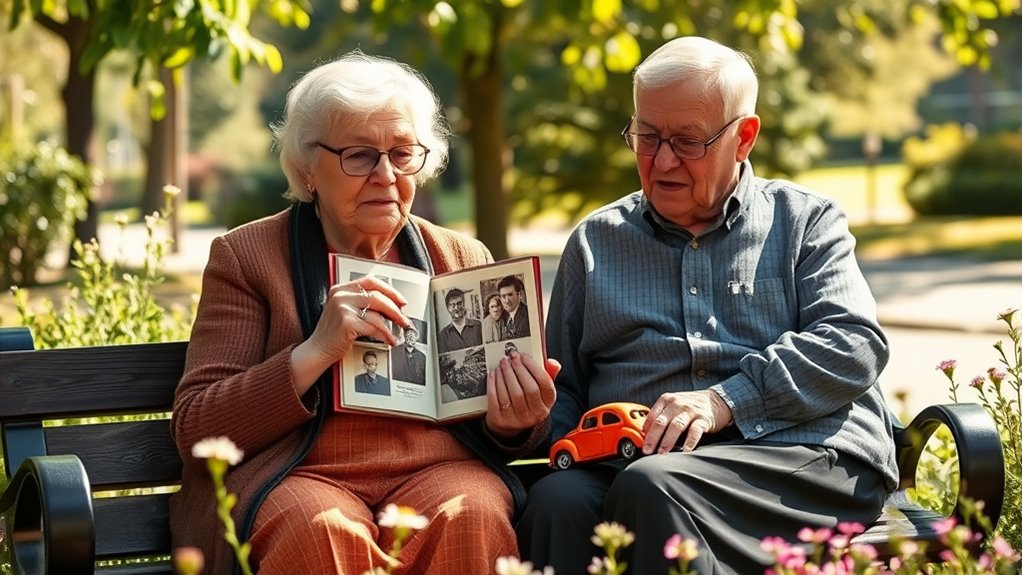
As people age, their nostalgic responses tend to change in meaningful ways. You’ll notice that different generations have unique emotional triggers, shaped by their cultural context. Here are three key points to contemplate:
Nostalgic responses evolve with age, shaped by cultural context and emotional growth.
- Generational differences influence what nostalgic memories resonate most strongly.
- As you grow older, your emotional maturity allows you to appreciate nostalgia more deeply, often appreciating the significance of past experiences.
- Older adults may seek comfort and stability in nostalgic feelings, while younger individuals might focus on novelty or identity formation.
Understanding these shifts helps you recognize that age shapes how you respond to nostalgic gifts. Your emotional maturity deepens your connection to certain memories, making the experience more meaningful.
The Power of Personal Stories and Memories in Gift-Giving

Personal stories and memories hold extraordinary power in gift-giving because they create a deep emotional connection that generic presents often can’t match. When you incorporate generational storytelling, you’re linking the recipient to their family history, making the gift more meaningful. Emotional storytelling transforms an ordinary item into a vessel of shared experience, evoking nostalgia and reinforcing bonds. By highlighting personal moments, you show you’ve paid attention to what truly matters, making the gift memorable. These stories can evoke feelings of pride, love, or longing, deepening the recipient’s emotional response. Ultimately, personal stories and memories turn a simple gift into a heartfelt gesture that celebrates individual history, strengthening relationships through the power of meaningful storytelling.
Practical Applications of Nostalgia in Marketing and Therapy

Nostalgia serves as a powerful tool in both marketing and therapy because it taps into deep emotional roots that influence behavior and well-being. In marketing, brands leverage nostalgia by promoting retro fashion and vintage decor, creating a sense of familiarity and comfort that encourages purchases. For example, using vintage-inspired designs or retro packaging connects consumers to positive memories. In therapy, nostalgia helps individuals process past experiences, fostering emotional resilience and well-being. Consider activities like reminiscing about childhood or exploring vintage memorabilia, which can evoke comforting memories. Here are three practical ways to apply nostalgia:
Nostalgia connects us to positive memories, boosting emotional resilience in therapy and encouraging comfort-driven choices in marketing.
- Use retro fashion and vintage decor in advertising campaigns to evoke positive feelings.
- Incorporate nostalgic elements in therapy sessions to aid emotional healing.
- Create immersive environments rooted in vintage decor to enhance customer engagement.
Frequently Asked Questions
How Does Nostalgia Influence Decision-Making Beyond Emotional Attachment?
Nostalgia influences your decision-making by triggering behavioral biases that can lead you to make impulsive choices. When you feel nostalgic, you might prioritize familiar, sentimental items over practical options, often overlooking rational considerations. This emotional pull can cause you to act quickly, driven more by the desire to recapture positive feelings than by logical analysis, making your choices more emotionally charged and less objectively reasoned.
Can Nostalgia-Induced Memories Distort Actual Past Events?
Nostalgia-induced memories can indeed distort actual past events, primarily through memory distortion and emotional bias. You might recall moments more fondly or idealize experiences, which skews reality. This emotional bias influences how you remember the past, often leading you to emphasize positive details while ignoring negatives. As a result, your nostalgic memories may not accurately reflect what truly happened, affecting your perception and decision-making based on these altered recollections.
Are There Differences in Nostalgic Responses Across Various Psychological Disorders?
Your emotional response to nostalgia can feel like a rollercoaster, with some psychological disorders amplifying or dampening these feelings. These differences influence therapeutic applications, helping tailor treatments to individual needs. Cultural variations also shape how people experience nostalgia, making responses uniquely personal. Recognizing these differences allows you to better understand emotional health and foster healing, showing that nostalgia’s power is both universal and deeply personal across diverse psychological landscapes.
How Do Individual Differences Affect Susceptibility to Nostalgic Triggers?
You’re more likely to be affected by nostalgic triggers based on your personality traits and cultural background. If you’re naturally sentimental or open to new experiences, you’ll probably feel nostalgic more often. Your cultural background also shapes what memories resonate with you. These individual differences influence how easily you’re triggered by familiar scents, sounds, or sights, making your nostalgic responses unique and tailored to your personal history and identity.
What Are the Long-Term Psychological Effects of Frequent Nostalgic Reminiscing?
Frequent nostalgic reminiscing can strengthen your memory through reinforcement, helping you recall positive past experiences more vividly. It also aids in mood regulation, offering comfort during stressful times. However, if you dwell excessively, it might hinder your present well-being or lead to longing for the past. Overall, engaging in nostalgia in moderation can boost your emotional resilience and foster a balanced perspective on your memories and current life.
Conclusion
Now that you understand how nostalgia deeply influences your emotions and memories, imagine harnessing this power in your own life. What if the next gift you give or receive could uncover hidden memories and forge stronger bonds? The secrets behind nostalgic triggers are closer than you think—and the potential for meaningful connection is waiting to be uncovered. Are you ready to tap into this timeless force and see where it takes you?









